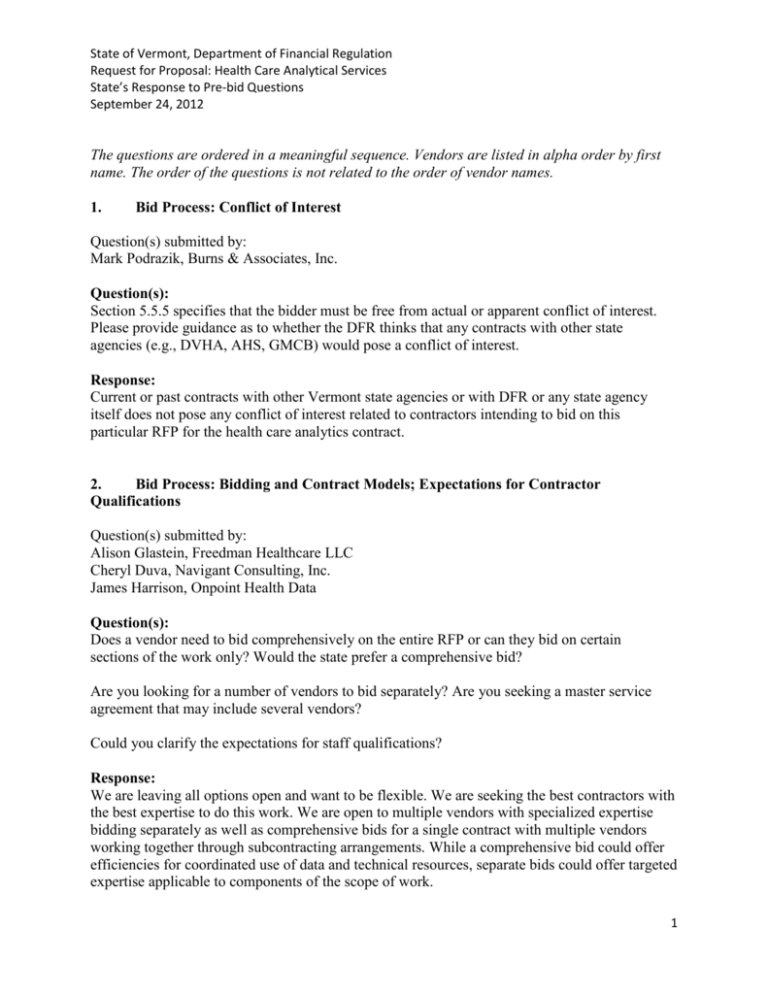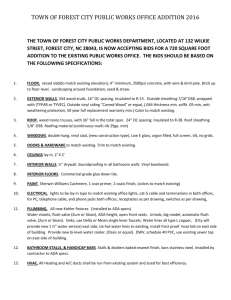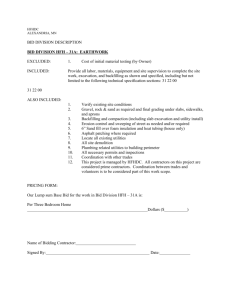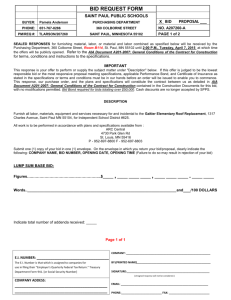DFR Response Questions_09242012_FINAL
advertisement

State of Vermont, Department of Financial Regulation Request for Proposal: Health Care Analytical Services State’s Response to Pre-bid Questions September 24, 2012 The questions are ordered in a meaningful sequence. Vendors are listed in alpha order by first name. The order of the questions is not related to the order of vendor names. 1. Bid Process: Conflict of Interest Question(s) submitted by: Mark Podrazik, Burns & Associates, Inc. Question(s): Section 5.5.5 specifies that the bidder must be free from actual or apparent conflict of interest. Please provide guidance as to whether the DFR thinks that any contracts with other state agencies (e.g., DVHA, AHS, GMCB) would pose a conflict of interest. Response: Current or past contracts with other Vermont state agencies or with DFR or any state agency itself does not pose any conflict of interest related to contractors intending to bid on this particular RFP for the health care analytics contract. 2. Bid Process: Bidding and Contract Models; Expectations for Contractor Qualifications Question(s) submitted by: Alison Glastein, Freedman Healthcare LLC Cheryl Duva, Navigant Consulting, Inc. James Harrison, Onpoint Health Data Question(s): Does a vendor need to bid comprehensively on the entire RFP or can they bid on certain sections of the work only? Would the state prefer a comprehensive bid? Are you looking for a number of vendors to bid separately? Are you seeking a master service agreement that may include several vendors? Could you clarify the expectations for staff qualifications? Response: We are leaving all options open and want to be flexible. We are seeking the best contractors with the best expertise to do this work. We are open to multiple vendors with specialized expertise bidding separately as well as comprehensive bids for a single contract with multiple vendors working together through subcontracting arrangements. While a comprehensive bid could offer efficiencies for coordinated use of data and technical resources, separate bids could offer targeted expertise applicable to components of the scope of work. 1 State of Vermont, Department of Financial Regulation Request for Proposal: Health Care Analytical Services State’s Response to Pre-bid Questions September 24, 2012 The RFP specifies that bidders need to identify key staff members who would be assigned to the contract and describe how their specific qualifications match up with the scope of work. We do not require project staff to be located on-site but will work with off-site staff. Key project team members must not be removed from the original line-up as identified in the proposal without discussing this with the State beforehand. We anticipate a lot of interaction between the project team, in-house staff, and other State officials as requested. 3. Bid Process: Bid Structure and Content Question(s) submitted by: Beth Schneider, Truven Health Analytics Paul Buckley, Public Consulting Group Question(s): Section 5.6.1, page 13- The instructions say the cost proposal should be “distinct from the technical proposal.” Does the State need to receive this in a separately sealed package, apart from the technical proposal, or is it sufficient that the cost bid be a separate stand-alone document within one sealed package along with the technical proposal? I am assuming that in Section 4, the Contractor Responsibilities are instructions to contractors that will be included in the contract. On page 6 there is a reference to a detailed Plan of Operation. Should this be included in the bid or deferred to the actual contract once a vendor is selected? Response: The cost bid does not need to be in a separate package and can be attached to the back of technical proposal. The cost proposal must be included in a comprehensive bid package that includes three major components including a technical bid, organizational experience, and cost bid in addition to the other documentation described in the RFP. The cost bid must be linked to the technical bid in a manner that incorporates the State’s cost bid approach described in the response to Question 5. The Plan of Operations will be developed by the selected vendor during contract negotiations. However, the bid needs to contain adequate detail about how the scope of work will be accomplished. 4. Bid Process: Deadline Question(s) submitted by: Rakhi Patil, Euclid Infotech Question(s): 2 State of Vermont, Department of Financial Regulation Request for Proposal: Health Care Analytical Services State’s Response to Pre-bid Questions September 24, 2012 Any Extension of Bidding Deadline? Response: The bidding deadline has not been extended. All bids are due on or before Monday October 8, 2012 at 4:00 p.m. ET. October 8 is a floating holiday for Vermont state government allowing employees to either take the day off as a holiday or to work and be compensated. Although State offices will be open on October 8, we will make an exception for any bids that are delivered on October 9, 2012 by 4:00 p.m. to ensure that all bids intended for delivery on October 8 are given an extra 24 hours. 5. Contract Budget and Cost Bid: Maximum Allowed and Bid Pricing Question(s) submitted by: Beth Schneider, Truven Health Analytics Cindy Thomas, Brandeis University James Harrison, Onpoint Health Data Mark Podrazik, Burns & Associates, Inc. Nancy Zoelzer, Milliman, Inc. Rakhi Patil , Euclid Infotech Sharon Williams, Navigant Consulting, Inc. Question(s): Does the State have an estimated budget range for the consulting services to be provided through this RFP? Estimated Budget for this Purchase? Is there an overall budget or ceiling on the bid amount? Section 5.6.1, page 13- Regarding the Cost Bid, has a budget been established for this project and if so is the State willing to share it with bidders? What level of effort and resources is expected for this contract? Given the fluidity of the types of analyses that may be completed under this engagement, please confirm that the DFR is not seeking a fixed price with this bid but just the hourly rate proposed per labor category. “5.6.2. Cost bids must be related to the functions and responsibilities outlined in Section 4.” We are clear that you want rates by labor category, but do you really want level of effort by task? 3 State of Vermont, Department of Financial Regulation Request for Proposal: Health Care Analytical Services State’s Response to Pre-bid Questions September 24, 2012 Section 5.6.1, page 13- Directions for the Cost Bid indicate that the “bidder shall offer a cost proposal…to provide one hourly rate for each staff class identified in the proposal.” Are bidders to provide estimated hours in the Cost Bid and/or a maximum contract payment amount, or will these be determined later? Section 5.6.1, page 13- Please confirm that travel expenses are to be billed as incurred, and not included in hourly rates. Section 5.6.1, page 13- Regarding the Cost Bid, is there a template or format that bidders should use to assure that consistent information is provided? Response: There is no estimated budget for this contract. The State requires an estimate of base hours for the technical services within the scope of work and hourly rates for every member of the project team including any subcontractors for each requested analytical component identified in the RFP. The cost bid must include a fixed price estimate for base deliverables based on estimated hours multiplied by the hourly rates for project staff. Hourly rates for project staff members should also include an indirect rate pertinent to the scope of work within the contract to cover administrative expenses, supplies, postage, and software licensing fees. The cost bid should also specify anticipated travel expenses including lodging, meals, and incidentals. Vehicle mileage will be reimbursed at a rate determined by the State at the time the contract is executed. The contract will include a separate maximum allowed amount for travel expenses that are reimbursed based on expense receipts submitted to the State for each travel episode. Bidders should use a template or format that clearly specifies every component of the cost bid as described above. 6. Cost Bid: Cost of VHCURES Data Set Question(s) submitted by: Beth Schneider, Truven Health Analytics Question(s): Section 4.2.2.1, page 9- Is the contractor responsible for any costs to access VHCURES, or will the data be provided by the State at no cost? If there is a cost to the vendor, could the State please provide an estimate? Response: 4 State of Vermont, Department of Financial Regulation Request for Proposal: Health Care Analytical Services State’s Response to Pre-bid Questions September 24, 2012 The VHCURES data set as required for execution of the State contract will be provided to the contractor at no cost. Cost Bid: GIS and Licensing Fees Question(s) submitted by: Beth Schneider, Truven Health Analytics Question(s): Regarding the use of Geographic Information Systems (GIS) technology, does the State have a preference for the GIS software to be used? Does the state have GIS licenses that can be used by the vendor, or is the vendor responsible for the costs of any needed software? Response: While the State does not have a preference for GIS software to be used, the State will review and approve all software tools recommended by the contractor to support analysis. The vendor is responsible for the cost of any needed software that should be accounted for in the cost bid as discussed in the response to Question 5. 7. Cost Bid: Selecting Software Tools and Licensing Fees Question(s) submitted by: Beth Schneider, Truven Health Analytics James Harrison, Onpoint Health Data Mark Podrazik, Burns & Associates, Inc. Question(s): Section 4.2.2.2, 5th bullet, requests assistance in evaluating widely available off-the-shelf analytical tools to estimate health status. If the DFR decides during this engagement that it is interested in having the Contractor use a particular software tool, would the Contractor be responsible for the cost of a license fee for the software, or would the DFR purchase the license and negotiate with the software vendor an approved use by the Contractor? Section 4.2.2.2, page 10- “The Contractor shall evaluate widely available tools used to measure health status.” Is this evaluation expected to include piloting use of the software on the VHCURES data? If so, is the Vendor responsible for the costs of any COTS software that may be evaluated? Will the state require the use of preferred software, groupers, and other analytic tools? 5 State of Vermont, Department of Financial Regulation Request for Proposal: Health Care Analytical Services State’s Response to Pre-bid Questions September 24, 2012 Will the state provide licenses for required software, groupers, and schemas or should these licensing fees be included in the bid? Section 5.6.1, page 13- Regarding the Cost Bid, if there are any costs beyond professional hourly rates and travel and miscellaneous expenses, such as hardware or software, how should these be itemized or addressed? Response: The State anticipates the application of software to the VHCURES data and other health data sources as available and appropriate to support the analytics within the scope of work of the contract. Contractor shall obtain approval by the State for any use of licenses software being proposed for use for analytical work under the contract. The cost bid should include any cost for anticipated use of analytical tools that include licensing fees for the software in the indirect rate as discussed in the response to Question 5. 8. Cost Bid: Episodes of Care and Software Licensing Fees Question(s) submitted by: Beth Schneider, Truven Health Analytics Kajal G. Pendse, Government Works, Inc. Question(s): Section 4.2.2.2, page 10- “The Contractor shall generate analysis based on Episodes of Care.” Is the State interested in leveraging Commercial-off-the-shelf (COTS) Episodes Groupers or developing custom episodes for this project? If the former, is the Vendor responsible for the costs of any COTS software? Does this contract need ‘Episode-based’ analytics? Response: The Contractor shall make recommendations to the State for episode grouping that the State will review and approve. A key concept articulated in the “Contractors Responsibilities” section of the RFP is that all analytical methods and tools be transparent. See the responses to Questions 5 and 7. 9. Scope of Work: Term and Time Line Question(s) submitted by: Nancy Zoelzer, Milliman, Inc. Sean Huse, Public Consulting Group, Inc. 6 State of Vermont, Department of Financial Regulation Request for Proposal: Health Care Analytical Services State’s Response to Pre-bid Questions September 24, 2012 Question(s): Does the State have any specific timing constraints (within the 2-year contract) for the specific analyses to be provided through the RFP? For example, are there interim dates by which the State desires to have specific analyses completed? What is the term of this contract? I see a start date of December 15, 2012. Response: The State will work with the contractor to set a timeline for deliverables within the scope of work that takes the following factors into account: priorities that emerge from the political and policy environment related to planning, implementing and evaluating health care reform initiatives; timely availability of data, analytical tools and models; and statutory mandates and/or grant-related requirements for analytics. This is a 2-year contract. The State is more disposed towards putting contracts out for competitive bid periodically rather than relying on sole source contracts for extended periods. 10. Scope of Work: Data Warehouse and Web Portal Question(s) submitted by: Cheryl Duva, Navigant Consulting, Inc. James Harrison, Onpoint Health Data Kajal G. Pendse, Government Works, Inc. Dr. Rudra, Government Works, Inc. Question(s): Does the contract require the contractor to a. Build a data warehouse by integrating data from the current VHCURES (VT Healthcare Claims Uniform Reporting and Evaluation System which is VT’s all payer database), VHHIS (VT Household Health Insurance Survey), VUHDDS (VT Uniform Hospital Discharge Data Set), BRFSS (VT Behavioral Risk Factor Surveillance Survey) and other sources to generate analytics and consulting for containing healthcare costs and improving quality of care for Vermonters Or b. Only provide consulting services using data in the current VT data bases without providing any tools or systems? Does the work involve only analytical services and consulting or does it also include building a system? Is analytic infrastructure development required since the data are relational? 7 State of Vermont, Department of Financial Regulation Request for Proposal: Health Care Analytical Services State’s Response to Pre-bid Questions September 24, 2012 Do you want the data stored in one place for meaningful analysis? Are you expecting analytic tools from the contract? Will the vendor be required to build an analytic warehouse for use both by the vendor and the state? Does the contract include building a web-based portal for users? Response: The contractor shall provide technical and consulting services to analyze data from multiple data sources as referred to under part a. of the first question. Based on this effort, the Contractor shall inform the State’s efforts to continuously improve existing health data sources and develop new resources as feasible by providing recommendations that will strengthen analytical capacity. The contract will be initially focused primarily on analytical services and consulting and not on building a new system or data warehouse. The state will issue a new RFP or negotiate to expand the scope of work if we want to develop an entirely new system or data warehouse. We will require the contractor to provide the necessary analytical tools needed to leverage the existing data to the fullest extent possible. The State will work out the details and nuances with the contractor during contract negotiations and development. The current contract will not require a web-based portal. The contract will focus on analysis of existing data and reporting in a manner that is accessible to a variety of users including the general public and targeted audiences. The goal of the administration and Green Mountain Care Board is transparency in methods and making reporting accessible to the public. 11. Scope of Work: Types, Content, Availability, Quality of Data Resources Question(s) submitted by: Cheryl Duva Navigant Consulting, Inc. Cindy Thomas, Brandeis University Dee O’Connor, JEN Associates, Inc. James Harrison, Onpoint Health Data Susan Melidosian, Navigant Consulting, Inc. Question(s): What state data sources will be provided to the vendor and how will the vendor access these data? Will the required data sources be available right away or at different intervals? Will analytic files be turned over to any new contractor? 8 State of Vermont, Department of Financial Regulation Request for Proposal: Health Care Analytical Services State’s Response to Pre-bid Questions September 24, 2012 How are the claims data refreshed and what is included in VHCURES? What is the VHCURES refresh process? Can the file be broken up or provided in a way that can be managed efficiently? Will the State provide any analytical tools? What is the most current data that will be available for the Vermont Household Health Insurance Survey? Are there data sources required to perform analyses detailed in the RFP that do not yet exist or are expected to be built during this project? Does the state anticipate any problems with access to and validity of the detailed payer administrative cost, detailed provider administrative cost, or policy benefit information? Response: As identified in the RFP, the State will make every effort to provide the contractor with all State data resources related to population demographics and socioeconomic status and risk/health status; health care expenditures and utilization; availability and distribution of health care resources; health care quality; and other data that may be necessary or useful to support comprehensive and useful analytics for planning, implementing, and evaluating health care reform initiatives. Baseline data sources include VHCURES claims data; hospital discharge data; and survey data such as VHHIS. After the required data use agreements have been signed that address data security and HIPAA requirements, the State will provide contractors with the necessary data sources such as VHCURES claims data, hospital discharge data, and any other data available to the State. The claims data will be available on a quarterly basis with updated and refreshed data. Each data refresh reflects what happened in the claims adjudication process related to new incurred claims and to paid claims amount related to withholds and reversals. The dollar amounts may change with each consolidation, especially for more recent claims while the older claims stabilize over time. VHCURES has an incurred service start data of January 1, 2007 and rolls forward to current with the major insurers and Medicaid submitting monthly eligibility and medical and pharmacy claims records. The State is working with CMS to procure a data use agreement and to integrate the Medicare claims data into VHCURES in the near future. The VHCURES file is consolidated on a quarterly basis and includes the historical data going back to January 2007. It is refreshed with new data from monthly and quarterly submitters and any new submitters. We are working with our data aggregation vendor to identify a potential solution to support secure user dial-in. If and until there is a dial-in option, the contractor 9 State of Vermont, Department of Financial Regulation Request for Proposal: Health Care Analytical Services State’s Response to Pre-bid Questions September 24, 2012 will receive quarterly consolidated files to support analysis. The contractor will provide their own tools for analytics. We will be working with our data aggregator to provide "Office Hours" for responding to data users’ questions about the data. The current size of VHCURES for data only is 200 GB. Double the size if the data are performance-tuned appropriately for all three data sets. Growth is between15-20 GB per quarter. Between Medicare, Commercial, and Medicaid, the separate payer sets are roughly the same size (68GB each currently). Each payer accounts for approximately 1/3 of the data. Due to the different cycles of data collection, aggregation, and availability, there will be limitations in achieving complete synchrony across all data sets related to data periods. While the VHCURES claims data are consolidated and available on a quarterly basis, the hospital discharge data set is released on an annual basis that may be lagged due to many factors including procurement of data from other states for Vermont residents. The latest Vermont Household Health Insurance Survey (VHHIS) is in the field right now. The survey data are scheduled to be available for release in early 2013 from the fall 2012 fielding. The State will provide assistance with any legal and/or technical challenges that may arise related to access to and validity of these types of information that will be required to support the State’s needs for analysis and reporting. The State anticipates that in a dynamic health care and technologic environment that new data sources will become available with the potential to support analytics. Acquisition and incorporation into analytics will be an iterative process. The cost bid should take into account the cost of any data resources that may be applicable to the proposed analytics that are proprietary and require a fee. The State shall review and approve any proprietary data sources recommended by the contractor. 12. Scope of Work: Expectations for Data Linkage Question(s) submitted by: Dee O’Connor, JEN Associates, Inc. Jim Harrison, Onpoint Health Data Kajal G. Pendse, Government Works, Inc. Question(s): Does this contract need interfaces with the State’s HIE and HIX databases? Will electronic medical record or similar clinical data be part of analytic effort? 10 State of Vermont, Department of Financial Regulation Request for Proposal: Health Care Analytical Services State’s Response to Pre-bid Questions September 24, 2012 Do the BFRSS, VUHDDS, and/or VHHIS surveys contain client identifying information that would make it possible to link the data to health claims? Response: Not at this time. State requests for new deliverables outside the scope of work of the contract will require contract amendments and State approval. The BRFSS is a cross-sectional telephone survey conducted by state health departments with technical and methodological assistance provided by the CDC. States conduct monthly telephone surveillance using a standardized questionnaire to determine the distribution of risk behaviors and health practices among non-institutionalized adults. Since BRFSS is just a sample of the Vermont population, it would not appear to be feasible or appropriate to perform any direct or probabilistic linkage with the other data sources that are not based on a sampling methodology for data collection. At this point in time, VHCURES and VUHDDS (hospital discharge data) do not include direct identifiers but do include some indirect identifiers and other data elements that could support probabilistic linking between de-identified data sets. 13. Scope of Work: Attribution Logic Question(s) submitted by: Kajal G. Pendse, Government Works, Inc. Question(s): Is the contractor required to apply ‘member attribution logic’ similar to the logic that CMS uses for ACO member attribution to evaluate health care systems ‘degree of responsibility’? Response: The State anticipates the need for member and patient attribution that will be driven by a variety of models that may include ACOs and/or MCOs in addition to other models of accountability, responsibility or assignment as identified and defined by the State. 14. Scope of Work: Pricing and Payment Accuracy Question(s) submitted by: Cheryl Duva, Navigant Consulting, Inc. Dee O’Connor, JEN Associates, Inc. James Harrison, Onpoint Health Data 11 State of Vermont, Department of Financial Regulation Request for Proposal: Health Care Analytical Services State’s Response to Pre-bid Questions September 24, 2012 Question(s): What type of analytics are anticipated around the "pricing failures and fraud and abuse" subject areas mentioned in the "identification of inefficiencies in health care spending" section? Is the State interested in the issue of payment accuracy related to eligibility, plan and benefit design? The Green Mountain Care Board Data Analytic Plan includes studies of administrative costs, for providers and payers as well as the relationship between premium increases, benefit changes and payer pure premium spending. Should such studies be included in the response to the RFP, and if so, what are the available data sources to address these administrative costs/charges? Response: The state will collaborate with the contractor to develop the analytics around pricing failures and fraud and abuse. Bidders should identify potential analytics applicable to these areas. The State understands that there are issues specific to different payer types such as retroactivity in Medicaid. On the commercial side, our data processor performs data quality checks on the percent of claims supported by eligibility records by insurer and works with insurers to understand and correct any irregularities. We will defer this specific detail to later discussions of expectations for analysis of claims expenditures. Yes, analysis of administrative cost should be addressed in the response to the RFP. The State has models and data sources and models that have been used to measure, estimate and analyze administrative cost. 15. Scope of Work: Master Indexes Question(s) submitted by: Kajal G. Pendse, Government Works, Inc. Question(s): Does the contract need Master Provider, Master Patient, and Master Payer Index for consolidating data of individual provider, patient and payer across different payers and different lines of business? Response: The VHCURES claims and eligibility data resource and data warehouse includes these features. They continue to improve as VHCURES matures and integrates more payers and data. Contractor shall provide technical assistance in identifying, improving and/or making recommendations to improve the indices in response to findings while developing and performing analytics. 12 State of Vermont, Department of Financial Regulation Request for Proposal: Health Care Analytical Services State’s Response to Pre-bid Questions September 24, 2012 16. Scope of Work: Risk Adjustment Question(s) submitted by: Kajal G. Pendse, Government Works, Inc. Question(s): Does this contract need a risk adjustment methodology for commercial and Medicaid members that is similar to the CMS’ HCC model that CMS uses for calculating monthly payments for Medicare members in MAOs? Response: The State will require risk adjustment for members within and across the different payer types. Contractor shall recommend methodologies that may be both proprietary and in the public domain for review and approval by the State. A key concept articulated in the “Contractors Responsibilities” section of the RFP is that all analytical methods and tools be transparent. 13






